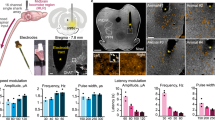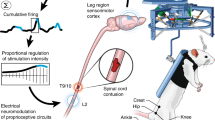Abstract
The spinal cord is essential to the control of locomotion in legged animals and humans. However, the actual circuitry of the spinal controller remains only vaguely understood. Here we approach this problem from the viewpoint of learning. More precisely, we assume the circuitry evolves through the transfer of control from the brain to the spinal cord, propose a specific learning mechanism for this transfer based on the error between the cord and brain contributions to muscle control, and study the resulting structure of the spinal controller in a simplified neuromuscular model of human locomotion. The model focuses on the leg rebound behavior in stance and represents the spinal circuitry with 150 muscle reflexes. We find that after learning a spinal controller has evolved that produces leg rebound motions in the absence of a central brain input with only three structural reflex groups. These groups contain individual reflexes well known from physiological experiments but thought to serve separate purposes in the control of human locomotion. Our results suggest a more holistic interpretation of the role of individual sensory projections in spinal networks than is common. In addition, we discuss potential neural correlates for the proposed learning mechanism that may be probed in experiments. Together with such experiments, neuromuscular models of spinal learning likely will become effective tools for uncovering the structure and development of the spinal control circuitry.







Similar content being viewed by others
References
Ahn, S.N., Guu, J.J., Tobin, A.J., Edgerton, V.R., & Tillakaratne, N.J. (2006). Use of c-fos to identify activity-dependent spinal neurons after stepping in intact adult rats. Spinal Cord, 44, 547–559.
Aoi, S., Ohashi, T., Bamba, R., Fujiki, S., Tamura, D., Funato, T., Senda, K., Ivanenko, Y., & Tsuchiya, K. (2019). Neuromusculoskeletal model that walks and runs across a speed range with a few motor control parameter changes based on the muscle synergy hypothesis. Scientific Reports, 9(1), 1–13.
Bailey, C.H., Giustetto, M., Huang, Y.Y., Hawkins, R.D., & Kandel, E.R. (2000). Is Heterosynaptic modulation essential for stabilizing hebbian plasiticity and memory. Nature Reviews Neuroscience, 1 (1), 11–20.
Barbeau, H., & Rossignol, S. (1987). Recovery of locomotion after chronic spinalization in the adult cat. Brain Research, 412(1), 84–95.
Bassett, D.S., Yang, M., Wymbs, N.F., & Grafton, S.T. (2015). Learning-induced autonomy of sensorimotor systems. Nature Neuroscience, 18(5), 744–751.
Bertrand, S., & Cazalets, J.-R. (2013). Activity-dependent synaptic plasticity and metaplasticity in spinal motor networks. Current Pharmaceutical Design, 19(24), 4498–4508.
Blickhan, R. (1989). The spring-mass model for running and hopping. J. of Biomech., 22, 1217–1227.
Brown, T.G. (1914). On the nature of the fundamental activity of the nervous centres; together with an analysis of the conditioning of rhythmic activity in progression, and a theory of the evolution of function in the nervous system. Journal of Physiology, 48(1), 18–46.
Chen, Y., Chen, X.Y., Jakeman, L.B., Chen, L., Stokes, B.T., & Wolpaw, J.R. (2006). Operant conditioning of H-reflex can correct a locomotor abnormality after spinal cord injury in rats. The Journal of Neuroscience, 26(48), 12537–12543.
Courtine, G., Gerasimenko, Y., van den Brand, R., Yew, A., Musienko, P., Zhong, H., Song, B., Ao, Y., Ichiyama, R.M., Lavrov, I., Roy, R.R., Sofroniew, M.V., & Edgerton, V.R. (2009). Transformation of nonfunctional spinal circuits into functional states after the loss of brain input. Nature Neuroscience, 12(10), 1333–1342.
Dietz, V. (2003). Spinal cord pattern generators for locomotion. Clinical Neurophysiology, 114 (8), 1379–1389.
Dorn, T.W., Wang, J.M., Hicks, J.L., & Delp, S.L. (2015). Predictive simulation generates human adaptations during loaded and inclined walking. PloS one, 10(4), e0121407.
Doyon, J., Gabitov, E., Vahdat, S., Lungu, O., & Boutin, A. (2018). Current issues related to motor sequence learning in humans. Current Opinion in Behavioral Sciences, 20, 89–97.
Dzeladini, F., van den Kieboom, J., & Ijspeert, A. (2014). The contribution of a central pattern generator in a reflex-based neuromuscular model. Frontiers in Human Neuroscience, 8, 1–18.
Edgerton, V.R., Tillakaratne, N.J., Bigbee, A.J., de Leon, R.D., & Roy, R.R. (2004). Plasticity of the spinal neural circuitry after injury. Annual Review of Neuroscience, 27, 145–167.
Ekeberg, O., & Pearson, K. (2005). Computer simulation of stepping in the hind legs of the cat: an examination of mechanisms regulating the stance-to-swing transition. Journal of Neurophysiology, 94(6), 4256–4268.
Forssberg, H., Grillner, S., & Halbertsma, J. (1980). The locomotion of the low spinal cat I. Coordination within a hindlimb. Acta Physiologica Scandinavica, 108(3), 269–281.
Geyer, H., Seyfarth, A., & Blickhan, R. (2003). Positive force feedback in bouncing gaits? Proceedings of the Royal Society B: Biological Sciences, 270(1529), 2173–2183.
Geyer, H., Seyfarth, A., & Blickhan, R. (2006). Compliant leg behaviour explains the basic dynamics of walking and running. Proceedings of the Royal Society of London B, 273, 2861–2867.
Geyer, H., & Herr, H.M. (2010). A muscle-reflex model that encodes principles of legged mechanics produces human walking dynamics and muscle activities. IEEE Transactions on Neural Systems and Rehabilitation Engineering, 18(3), 263–273.
Gu̇nther, M., & Ruder, H. (2003). Synthesis of two-dimensional human walking: a test of the λ-model. Biological Cybernetics, 89, 89–106.
Haith, A.M., & Krakauer, J.W. (2013). Theoretical models of motor control and motor learning. Routledge Handbook of Motor Control and Motor Learning.
Harkema, S.J. (2001). Neural plasticity after human spinal cord injury: Application of locomotor training to the rehabilitation of walking. The Neuroscientist, 7(5), 455–468.
Haruno, M., Wolpert, D.M., & Kawato, M. (2001). MOSAIC Model for sensorimotor learning and control. Neural Computation, 13(10), 2201–2220.
Hase, K., & Yamazaki, N. (2002). Computer simulation study of human locomotion with a three-dimensional entire-body neuro-musculo-skeletal nodel. JSME International Journal Series C Mechnical Systems, Machine Elements and Manufacturing, 45(4), 1040–1050.
Heess, N., Sriram, S., Lemmon, J., Merel, J., Wayne, G., Tassa, Y., Erez, T., Wang, Z., Eslami, S.M.A., Riedmiller, M., & Silver, D. (2017). Emergence of locomotion behaviours in rich environments. arXiv:1707.02286.
Hubli, M., & Dietz, V. (2013). The physiological basis of neurorehabilitation-locomotor training after spinal cord injury. Journal of Neuroengineering and Rehabilitation, 10(1), 5.
Hultborn, H. (2001). State-dependent modulation of sensory feedback. Journal of Physiology, 533(1), 5–13.
Ijspeert, A.J. (2008). Central pattern generators for locomotion control in animals and robots: a review. Neural Networks, 21(4), 642– 653.
Jankowska, E. (2013). Spinal Interneurons. In Pfaff, D. W., & Volkow, N. D. (Eds.) Neuroscience in the 21st Century: From Basic to Clinical, chapter 30 (pp. 1063–1099): Springer.
Kawato, M., Furukawa, K., & Suzuki, R. (1987). A hierarchical neural-network model for control and learning of voluntary movement. Biological Cybernetics, 57(3), 169–185.
Kawato, M., & Gomi, H. (1992). A computational model of four regions of the cerebellum based on feedback-error learning. Biological Cybernetics, 68(2), 95–103.
Kiehn, O. (2016). Decoding the organization of spinal circuits that control locomotion. Nature Reviews Neuroscience, 17(4), 224–238.
Kohl, N., & Stone, P. (2004). Policy gradient reinforcement learning for fast quadrupedal locomotion. In IEEE International Conference on Robotics and Automation. 2004, Proceedings. ICRA ’04, (Vol. 3 pp. 2619–2624).
Manoonpong, P., Geng, T., Kulvicius, T., Porr, B., & Wȯrgȯtter, F. (2007). Adaptive, fast walking in a biped robot under neuronal control and learning. PLoS Computational Biology, 3(7), e134.
Markin, S.N., Klishko, A.N., Shevtsova, N.A., Lemay, M.A., Prilutsky, B.I., & Rybak, I.A. (2016). A Neuromechanical Model of Spinal Control of Locomotion. In Prilutsky, B., & Edwards, D. (Eds.) Neuromechanical modeling of posture and locomotion. Springer Series in Computational Neuroscience (pp. 21–65). New York: Springer.
Nakanishi, J., Morimoto, J., Endo, G., Cheng, G., Schaal, S., & Kawato, M. (2004). Learning from demonstration and adaptation of biped locomotion. Robotics and Autonomous Systems, 47, 79– 91.
Nielsen, J.B., & Sinkjaer, T. (2002). Afferent feedback in the control of human gait. Journal of Electromyography and Kinesiology, 12(3), 213–217.
Pierrot-Desseilligny, E., & Burke, D.C. (2012). The circuitry of the human spinal cord: spinal and corticospinal mechanisms of movement. Cambridge: Cambridge University Press.
Poldrack, R.A., Sabb, F.W., Foerde, K., Tom, S.M., Asarnow, R.F., Bookheimer, S.Y., & Knowlton, B.J. (2005). The neural correlates of motor skill automaticity. Journal of Neuroscience, 25(22), 5356–5364.
Porr, B., & Wȯrgȯtter, F. (2003). Isotropic sequence order learning. Neural Computation, 15 (4), 831–864.
Prochazka, A., & Yakovenko, S. (2007). The neuromechanical tuning hypothesis. Progress in Brain Research, 165, 255–265.
Quilgars, C., & Bertrand, S.S. (2019). Activity-dependent synaptic dynamics in motor circuits of the spinal cord. Current Opinion in Physiology, 8, 44–49.
Raineteau, O., & Schwab, M.E. (2001). Plasticity of motor systems after incomplete spinal cord injury. Nature Reviews Neuroscience, 2(4), 263–273.
Rejc, E., Angeli, C.A., Atkinson, D., & Harkema, S.J. (2017). Motor recovery after activity-based training with spinal cord epidural stimulation in a chronic motor complete paraplegic. Scientific Reports, 7(1), 13476.
Rossignol, S. (2006). Plasticity of connections underlying locomotor recovery after central and/or peripheral lesions in the adult mammals. Philosophical Transactions of the Royal Society B: Biological Sciences, 361(1473), 1647–1671.
Rybak, I.A., Shevtsova, N.A., Lafreniere-Roula, M., & McCrea, D.A. (2006). Modelling spinal circuitry involved in locomotor pattern generation: insights from deletions during fictive locomotion. Journal of Physiology, 577(Pt 2), 617–639.
Seyfarth, A., Gu̇nther, M., & Blickhan, R. (2001). Stable operation of an elastic three-segmented leg. Biological Cybernetics, 84, 365–382.
Song, S., & Geyer, H. (2015). A neural circuitry that emphasizes spinal feedbacks generates diverse behaviours of human locomotion. Journal of Physiology, 593(16), 3493–3511.
Stuart, G., Spruston, N., & Häusser, M. (Eds.) (2016). Dendrites, 3rd edn. Oxford: Oxford University Press.
Taga, G., Yamaguchi, Y., & Shimizu, H. (1991). Self-organized control of bipedal locomotion by neural oscillators in unpredictable environment. Biological Cybernetics, 65(3), 147–159.
Thompson, A.K., & Wolpaw, J.R. (2014). Restoring walking after spinal cord injury: operant conditioning of spinal reflexes can help. The Neuroscientist, 21(2), 203–215.
Vahdat, S., Lungu, O., Cohen-Adad, J., Marchand-Pauvert, V., Benali, H., & Doyon, J. (2015). Simultaneous brain-cervical cord fMRI reveals intrinsic spinal cord plasticity during motor sequence learning. PLoS Biology, 13(6), e1002186.
Wang, J.M., Hamner, S.R., Delp, S.L., & Koltun, V. (2012). Optimizing locomotion controllers using biologically-based actuators and objectives. ACM Transactions on Graphics, 31(4), 25.
Widrow, B., & Hoff, M.E. (1960). Adaptive switching circuits. In 1960 IRE WESCON Convention Record (pp. 96–104).
Wolpaw, J.R., & Tennissen, A.M. (2001). Activity-dependent spinal cord plasticity in health and disease. Annual Review of Neuroscience, 24(1), 807–843.
Wolpaw, J.R. (2010). What can the spinal cord teach us about learning and memory? The Neuroscientist, 16(5), 532–549.
Wolpert, D.M., & Kawato, M. (1998a). Multiple paired forward and inverse models for motor control. Neural Networks, 11(7-8), 1317–1329.
Wolpert, D.M., Miall, R., & Kawato, M. (1998b). Internal models in the cerebellum. Trends in Cognitive Sciences, 2(9), 338–347.
Wolpert, D.M., Diedrichsen, J., & Flanagan, J.R. (2011). Principles of sensorimotor learning. Nature Reviews Neuroscience, 12, 739–751.
Yuste, R., & Tank, D.W. (1996). Dendritic integration in mammalian neurons, a century after Cajal. Neuron, 16(4), 701–716.
Acknowledgments
The authors would like to thank the anonymous reviewers for helpful comments and suggestions, which led to substantial improvements of the paper.
Author information
Authors and Affiliations
Corresponding author
Ethics declarations
Conflict of interests
The authors declare that they have no conflict of interest.
Additional information
Action Editor: Charles Wilson
Publisher’s note
Springer Nature remains neutral with regard to jurisdictional claims in published maps and institutional affiliations.
Rights and permissions
About this article
Cite this article
Sar, P., Geyer, H. A model for the transfer of control from the brain to the spinal cord through synaptic learning. J Comput Neurosci 48, 365–375 (2020). https://doi.org/10.1007/s10827-020-00767-0
Received:
Revised:
Accepted:
Published:
Issue Date:
DOI: https://doi.org/10.1007/s10827-020-00767-0




